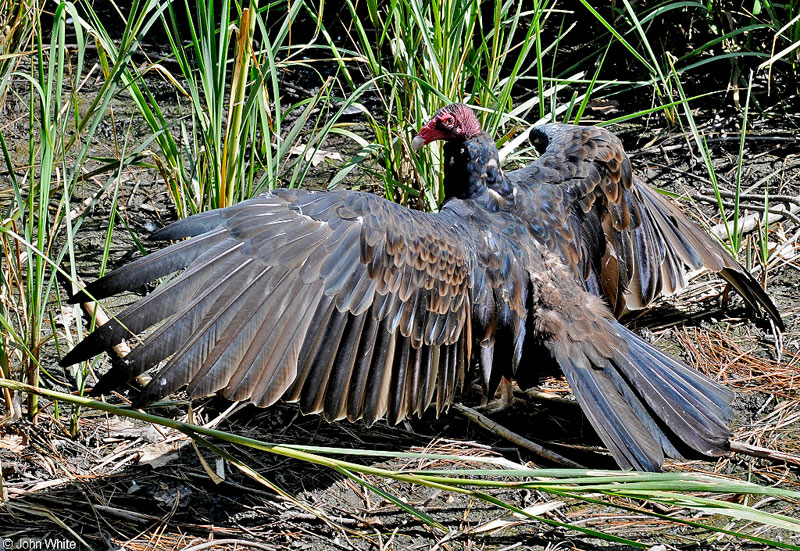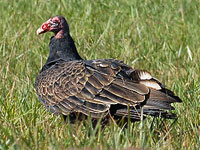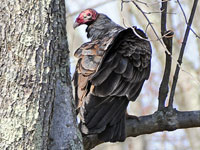|
||||
|
||||
Turkey Vulture or Turkey Buzzard
Cathartes aura
Description: The turkey vulture is an eagle-sized blackish bird; it has a dark brown to black plumage; a featherless, purple-red head and neck (gray or brown in immatures); a long tail; and a short, hooked, ivory-colored beak. It’s a large bird with an average weight of 1.4 kg (3.1 lb) and a wingspan of 173-183 cm (68-72 inches).
In flight, the wings are held upward in a wide, shallow V; its flight feathers are silvery below. Cathartes aura wings are similar to black vultures but narrower. They flap their wings less frequently, rolls and sways from side to side, and is held well above horizontal.
Habitat: The turkey vulture is the most abundant vulture in the Americas. It is widespread over open country, subtropical forests, shrublands, deserts, and foothills; also in pastures, grasslands, deciduous forests, woodlands, adjacent farmlands, and wetlands.
It is found in open and semi-open areas throughout the Americans from southern Canada to Cape Horn. They have permanent residence in the southern United States, though northern birds may migrate as far south as South America.
The Turkey Vulture has a large range, with an estimated global occurrence of 28,000,000 km2. Its global population is estimated to be 4,500,000 individuals. Turkey vultures breed from southern British Columbia, central Saskatchewan, Great Lakes, and New Hampshire southward. Winters in Southwest, and in East northward to southern New England.
Breeding: The breeding season of the turkey vulture starts in March, peaks in April to May, and continues into June. The courtship rituals involve several individuals gathering in a circle, where they perform hopping movements around the perimeter of the circle with wings partially spread. In the air, one bird closely follows another while flapping and diving.
Cathartes aura don’t make nests. Eggs are generally laid on a bare surface in a protected location, such as a cliff, cave, rock crevice, burrow, inside a hollow tree, or in a thicket. Females generally lay two eggs, but sometimes one and rarely three. The eggs are whitish/cream colored and heavily marked with dark brown or lavender spots around their larger end.
Both parents incubate, and the young hatch after 30 to 40 days. Chicks are altricial, or helpless at birth. Both adults feed the chicks by regurgitating food for them, and care for them for 10 to 11 weeks.
When adults are threatened while nesting, they may flee, or they may regurgitate on the intruder or feign death. If the chicks are threatened in the nest, they defend themselves by hissing and regurgitating. The young fledge at about nine to ten weeks. Family groups remain together until fall.
Behavior: The Turkey Vulture is gregarious and roosts in large community groups, breaking away to forage independently during the day. Several hundred vultures may roost communally in groups, which sometimes even include Black Vultures.
It roosts on dead, leafless trees. Though they sometimes will nest in caves, it does not enter them except during the breeding season. The Turkey Vulture lowers its night-time body temperature by about 6°C (11°F) to 34°C (93°F), becoming slightly hypothermic.
The Turkey Vulture is awkward on the ground with an ungainly, hopping walk. It requires a great deal of effort to take flight, flapping its wings while pushing off the ground and hopping with its feet.
While soaring, the Turkey Vultures holds its wings in a shallow V-shape and often tips from side to side, frequently causing the gray flight feathers to appear silvery as they catch the light. Individuals scatter widely and soar high with unequaled mastery of the air as they tilt and teeter to take advantage of the slightest thermal. This is an example of static soaring flight, which uses rising thermals to stay strong and infrequently use their wings.
This vulture is often seen standing in a spread-winged stance. The stance is believed to serve multiple functions: drying the wings, warming the body, and baking off bacteria. It is practiced more often following damp or rainy nights. This same behavior is displayed by other New World vultures, by Old World vultures, and by storks.
Like storks, the Turkey Vulture often defecates on its own legs, using the evaporation of the water in the feces and/or urine to cool itself, a process known as urohydrosis. It cools the blood vessels in the unfeathered tarsi and feet, and causes white uric acid to streak the legs. The Turkey Vulture has few natural predators.
Its primary form of defense is regurgitating semi-digested meat, a foul-smelling substance that deters most creatures intent on raiding a vulture nest. It will also sting if the predator is close enough to get the vomit in its face or eyes. In some cases, the vulture must rid its crop of a heavy, undigested meal in order to take flight to flee from a potential predator.
Diet: The Turkey Vulture feeds primarily on a wide variety of carrion, from small mammals to large grazers, preferring those recently dead, and avoiding carcasses that have reached the point of putrefaction. It may rarely feed on plant matter, shoreline vegetation, pumpkin and other crops, live insects and other invertebrates.
The Turkey Vulture forages by smell, an ability that is uncommon in the avian world. It often will fly low to the ground to pick up the scent of ethyl mercaptan, a gas produced by the beginnings of decay in dead animals. In South America, it has been seen (and photographed) feeding on the fruits of the introduced Oil Palm. It rarely, if ever, kills prey itself.
The Turkey Vulture can often be seen along roadsides feeding on roadkill, or near bodies of water, feeding on washed-up fish. It also will feed on fish or insects that have become stranded in shallow water. Like other vultures, it plays an important role in the ecosystem by disposing of carrion that would otherwise be a breeding ground for disease.
Interesting Facts: The Turkey Vulture is sometimes accused of carrying anthrax or hog cholera, both livestock diseases, on its feet or bill by cattle ranchers and is therefore occasionally perceived as a threat. However, the virus that causes hog cholera is destroyed when it passes through the Turkey Vulture's digestive tract.
This species also may be perceived as a threat by farmers due to the similar Black Vulture's tendency to attack and kill newborn cattle. The Turkey Vulture does not kill live animals but will mix with flocks of Black Vultures and scavenge what they leave behind.
The Turkey Vulture species receives special legal protections under the Migratory Bird Treaty Act of 1918 in the United States, by the Convention for the Protection of Migratory Birds in Canada, and by the Convention for the Protection of Migratory Birds and Game Mammals in Mexico. In the USA it is illegal to take, kill, or possess Turkey Vultures, and violation of the law is punishable by a fine of up to 15,000 US dollars and imprisonment of up to six months.
Source(s):
“Turkey Vulture.” Wikipedia: The Free Encyclopedia. 25 May 2009. 29 May 2009.
Brown, Bill, Brown, William L., and Hilty, Steven L. A guide to the birds of Colombia. Edition: illustrated. Published by Princeton University Press, 1986.
Home | Upcoming Events | About Us | Resources | News | Local Contacts Maps | Publications | Youth Education | Links | Donate |








